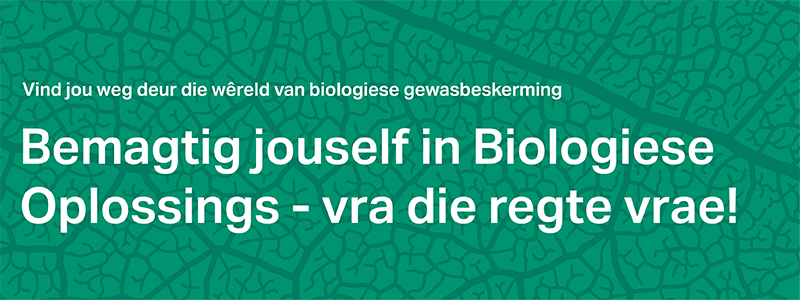
Biological crop protection products are gaining popularity as sustainable alternatives in agriculture. However, the rise in demand has led to new suppliers with varied claims, making it crucial for farmers to carefully evaluate products and vet suppliers.
Substandard products undermine farmer confidence and hinder the biorational industry’s growth. Asking key questions and understanding the market help identify ethical suppliers, ensuring sustainable and reliable pest management.
1. Understanding the Supplier’s Expertise and Credibility

Active Ingredient and Mode of Action
Request a detailed overview of the active ingredient and its mode of action (MoA). Understanding how it targets pests and recognising signs of infection can help assess its effectiveness based on crop quality or yield improvements.

Clarification of Technical Terms
Suppliers should clarify technical terms like “spores per gram” or “CFU” to help farmers understand the products composition and impact.

Compatibility and Safety
Farmers should check the product’s compatibility with other remedies and ensure safe mixing and application for optimal effectiveness.

Realistic Expectations and Background Verification
Suppliers should set realistic expectations for results and provide clear time frames. Verifying the supplier’s credibility through registration contact details, and industry affiliations ensures reliability.

Trial Results and Environmental Suitability
Suppliers should provide trial results from similar environments to help farmers assess product performance and make informed decisions.
2. Evaluating the Biological Product

Product Registration and Trials
Verify the product’s registration and ensure it has undergone legitimate trials in various climates, assessed by relevant authorities. (L-Registrations vs M-Registrations- Act 36 of 1947.)

Formulation and Efficacy
Determine if the product is purely biological or a hybrid with synthetics. Compare its efficacy to conventional products and check its registration for other crops and pests.

Application Guidance
Ensure clear instructions on timing, frequency, compatibility, storage, shelf-life, and handling to maintain efficacy.

Safety and Environmental Impact
Check safety for workers, livestock, and the environment, including MRL, PHI, REI, and GHS classification for compliance.

Integration with Farming Programs
Ensure compatibility with ICM, IPM, and IRM programs to enhance farming effectiveness.
3. Final Considerations

Cost and Value
Evaluate cost/hectare or application and consider whether the product adds value.

Phytotoxicity and Usage Restrictions
Address risks of phytotoxicity or physical damage to plants.

Compatibility and Safety
Farmers should check the product’s compatibility with other remedies and ensure safe mixing and application for optimal effectiveness.
Thank you to the following people for their valuable input:
Mr. Ben Krog, Ms. Wilma MacPherson, Mr. Chris Thompson, Mr. Andre Broeksma, Mr. Matt Janks, Dr. Chantal Janks, Dr. Justin Hatting, Dr. Colleen Hepburn, Dr. Anna Landwehr and Dr. Heidi Widmer.

Om kernvrae te vra en die mark te verstaan, lei daartoe dat etiese verskaffers geïdentifiseer word, wat volhoubare en betroubare plaagbestuur verseker.
1. Ondersoek die verskaffer se kundigheid en geloofwaardigheid

Aktiewe bestanddeel en werkingswyse
Versoek ‘n gedetailleerde oorsig van die aktiewe bestanddeel en sy werkings-wyse. Deur te verstaan hoe dit plae en plant tekens van infeksie kan daartoe bydra dat gewaskwaliteit of opbrengsverbetering kan dui op doeltreffendheid.

Verduideliking van tegniese terminologie
Verskaffers moet tegniese terme soos “spore per gram” of “CFU” verduidelik om boere te help om die produk se samestelling en impak te verstaan.

Verenigbaarheid en veiligheid
Produsente moet die produk se verenigbaarheid met ander middels nagaan en seker maak dat die produk= veilig gemeng en toegedien word om optimale doeltreffendheid te verseker.

Realistiese verwagtinge en agtergrondverifikasie
Verskaffers moet realistiese verwagtinge vir resultate stel en duidelike tydsraamwerke verskaf. Die verifiëring van die verskaffer se geloofwaardigheid deur registrasie-inligting, kontakbesonderhede en bedryfsaffiliasies te kontroleer, verseker die verskaffer se betroubaarheid.

Proefresultate en omgewings-geskiktheid
Verskaffers moet proefresultate uit soortgelyke omgewings verskaf om boere te help om produkprestasie te evalueer en ingeligte besluite te neem.
2. Evalueer die biologiese produk

Produkregistrasie en proewe
Verifieer die produk se registrasie en verseker dat dit wettige proewe in verskeie klimate ondergaan het, en deur die relevante owerhede geëvalueer is. (L-registrasies vs. M-registrasies – Wet 36 van 1947.)

Formulering en doeltreffendheid
Bepaal of die produk suiwer biologies of ‘n vermenging van sintetiese middels is. Vergelyk die doeltreffendheid daarvan met konvensionele produkte en kontroleer die registrasie daarvan vir gebruik in ander gewasse en plae.

Instruksies vir toediening
Duidelike instruksies rakende tydsberekening en frekwensie van toediening, verenigbaarheid, bergingsinstruksies, raklewe, en hantering om effektiwiteit te behou.

Veiligheid en omgewingsimpak
Kontroleer die veiligheid van die produk vir werkers, diere en die omgewing, insluitend of die produk aan MRL-, VOI (vooroes interval), herbetredingsinterval en GHS-klassifikasies voldoen.

Integrasie met boerderyprogramme
Maak seker dat die produk verenigbaar is met GGB-(geintegreerde gewasbestuur), GPB- en IRM-programme om sodoende boerderye se doeltreffendheid te verbeter.
3. Finale oorwegings

Koste
en waarde
Evalueer die koste/hektaar of toediening, en besluit of die produk waarde sal toevoeg.

Fitotoksisiteit en gebruiksbeperkings
Spreek die risiko’s van fitotoksisiteit of fisiese skade aan plante aan.

Organiese
sertifisering
Verifieer die akkreditasie en maak seker dat die produk aan alle wetlike vereistes voldoen.
Dankie aan die volgende mense vir hul waardevolle insette:
Mr. Ben Krog, Ms. Wilma MacPherson, Mr. Chris Thompson, Mr. Andre Broeksma, Mr. Matt Janks, Dr. Chantal Janks, Dr. Justin Hatting, Dr. Colleen Hepburn, Dr. Anna Landwehr and Dr. Heidi Widmer.
